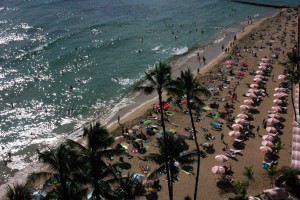Hawaii’s Still The Ultimate Island Getaway
 Imagine a land where the extraordinary is ordinary — daily rainbows, endless waterfalls, same-day surfing and snow skiing and championship golf bordering water hazards known as the Pacific Ocean.
Imagine a land where the extraordinary is ordinary — daily rainbows, endless waterfalls, same-day surfing and snow skiing and championship golf bordering water hazards known as the Pacific Ocean.
In short . . . imagine Hawaii.
Surrounded by the world’s largest body of water, Hawaii is earth’s most geographically isolated land mass. Situated in the midst of the Pacific Ocean, it is 2,500 miles from the nearest continent.
By U. S. standards, Hawaii’s history is one-of-a-kind, setting this state much further from the mainland than its distance in miles.
Captain James Cook discovered the islands in 1778. Pele, the goddess of volcanoes, remains a revered legend on the Big Island. And Oahu’s Iolani Palace is the only royal residence on American soil (King Kalakaua and Queen Liliuokalani lived there until the monarchy toppled in 1893). But while the spirit of aloha is the thread that links Hawaii, its four principal islands are distinctively different.
Oahu: The Gathering Place
No other American city offers Honolulu’s versatility to hike inside a dormant volcano (Diamond Head), visit a World War II landmark (U.S.S. Arizona Memorial), surf the world’s biggest waves (Banzai Pipeline) and dine in a five-star restaurant — in one day.
Though its best known attraction is Waikiki Beach, there is more going on in Oahu than the application of sunscreen. It’s called action. A true “gathering place,” the island lives up to its moniker, sporting more hotels, more restaurants and more major attractions than each of its neighboring islands. Oahu is where favorite spots spill over.
Hawaii: The Big Island
At 4,028 square miles, the island of Hawaii is twice as large as the other Hawaiian islands combined. And with the constant volcanic activity of Kilauea, it continues to add shoreline — making the 800,000-year-old Big Island even bigger with each lava spill into the sea.
If a visit to Waikiki translates to action, then adventure is synonymous with the Big Island. Whether it’s horseback riding in Waimea, snow skiing on Mauna Kea, kayaking off Kona or golfing everywhere . . . it’s available. And if an athletic endeavor of any sort is too strenuous, a lazy alternative might be found atop an air mattress in a sheltered lagoon.
Hawaii is an island of superlatives — it is home to the world’s most active volcano, the setting of 11 of earth’s 13 climatic regions (excluding the Arctic and the Sahara) and noted as the Golf Capital of the Hawaiian Islands (18 golf courses). It is a study in contrasts. Hilo, the island’s largest town, takes one back to a quieter, more tranquil time, whereas the opposite coast of Kona lies at the opposite end of the activity spectrum.
Maui: The Valley Island
Walking along this island’s Wailea shore on an early winter morning when the air is still and the ocean calm is prime time for whale watching, a long-time Maui staple. The immense mammal began shaping the island two centuries ago, when Lahaina became the lusty port of the Yankee whaling fleet in the early 19th century. Today’s Lahaina reflects this colorful past. Much of the town has been designated a historic district. The survivors — former grog shops in weathered wood buildings along Front Street— now house boutiques, art galleries and seafood restaurants.
On the far edge of the island is Hana. Referred to as the “other side” (indicative of its remoteness), it sits on Maui’s western end. The town is easily reached by air (helicopter transport past roaring waterfalls and intermittent rainbows is beyond memorable) or after negotiating an arduous 56-mile road that winds around 600 curves and crosses 54 one-lane bridges.
But whatever the means of arrival, rewards for the journey can be found in the understated indulgence of Hotel Hana-Maui and in the outdoor beauty of Oheo Gulch, a hiking spectacle where waterfalls spill into tiered pools that eventually lead to the sea.
At first glance, Maui seems a simple paradise, but beneath its wonders — wonders like those discovered at the end of the road to Hana — this valley island is the sophisticated sister to its siblings. Maui is lavish in its diversity. Over 100 years ago, the island’s sugar cane fields were described as “rippling in the trade winds like an emerald sea.” While they still do, the view of this “emerald sea” is nowadays rivaled by the manicured greens of championship golf courses; and furthering its cosmopolitan commitment is the island’s collection of grand resorts. Sprinkled liberally throughout Kapalua, Kaanapali and Wailea — the result is an unapologetically world-class Maui.
Kauai: The Garden Island
Mother Nature showered extraordinary gifts on Kauai. Nurtured by abundant rains, water spills from the interior’s forested wilderness and wends through valleys and canyons — sometimes moving lazily downstream and sometimes pouring thunderously over cliff tops. The result is a lush, luxuriant island getaway. Dubbed the “Garden Isle,” Kauai showcases its flourishing terrain — the rugged Na Pali coast, the thickly-vegetated Fern Grotto and the 10-mile long, 3,500-ft. deep Waimea Canyon(nicknamed the Grand Canyon of the Pacific by Mark Twain).
These natural wonders have made Kauai a busy location for film and television production — Jurassic Park and Raiders of the Lost Ark are just two of the many movies filmed on the island. Home to 43 white-sand beaches—more beach per mile of coastline than the other islands — Kauai is dedicated to preserving its unparalleled environment. To that end, no structure can be built more than four stories high, the approximate height of a mature coconut palm.
As the oldest of Hawaii’s main islands, Kauai’s guiding principle has long been to offer more tradition than trend. And true to its goal, Kauai is an echo of an earlier era.
Hawaiian Islands
When viewed through the paradise prism, Hawaii isn’t really that different from other island getaways: the water is just a little bluer, the mountains a bit greener and the sand a touch softer.
_____________________________________________________________
 As a freelance travel writer and photographer since 1988, Cynthia Dial has visited the world’s seven continents (most recently Antarctica) in quest of a good story . . . from getting her hair cut in Paris, horse whispering in Hawaii and touring Burma (Myanmar) only months after Aung San Suu Kyi’s release . . . to celebrating Summer Solstice within Finland’s Arctic Circle, hiking to Machu Picchu and visiting Molakai’s former leper colony atop a mule alongside a plunging cliff. In short, she experiences and writes about topics at the top of many readers’ bucket lists. Cynthia is author of the award-winning non-fiction book, Get Your Travel Writing Published. Now in its third printing, it was published in London, England, and sold worldwide (U.S. distributor is McGraw-Hill). Among her outlets are national and international newspapers and magazines including, Time magazine, Hemispheres, Destinations Weddings & Honeymoons, Shape, Dallas Morning News and the Toronto Star (which featured her around-the-world shopping column, Shopping Trips). She also contributes to TraveLife Magazine (distributed throughout Canada) and JustLuxe.com (a luxury portal receiving 2.1 million monthly hits). Cynthia’s radio experience includes World Footprints Radio (formerly Travel’n On) and the Travel Hub show on WorldTalk Radio, on which her No Passport Required segment was a regular feature. She additionally appears as a travel specialist on LiveFitMagazine.com. The travel-addicted writer admits that each time she steps onto an international flight, boards a train or steps onto a ship’s promenade deck to go to work, she congratulates herself on her career choice.
As a freelance travel writer and photographer since 1988, Cynthia Dial has visited the world’s seven continents (most recently Antarctica) in quest of a good story . . . from getting her hair cut in Paris, horse whispering in Hawaii and touring Burma (Myanmar) only months after Aung San Suu Kyi’s release . . . to celebrating Summer Solstice within Finland’s Arctic Circle, hiking to Machu Picchu and visiting Molakai’s former leper colony atop a mule alongside a plunging cliff. In short, she experiences and writes about topics at the top of many readers’ bucket lists. Cynthia is author of the award-winning non-fiction book, Get Your Travel Writing Published. Now in its third printing, it was published in London, England, and sold worldwide (U.S. distributor is McGraw-Hill). Among her outlets are national and international newspapers and magazines including, Time magazine, Hemispheres, Destinations Weddings & Honeymoons, Shape, Dallas Morning News and the Toronto Star (which featured her around-the-world shopping column, Shopping Trips). She also contributes to TraveLife Magazine (distributed throughout Canada) and JustLuxe.com (a luxury portal receiving 2.1 million monthly hits). Cynthia’s radio experience includes World Footprints Radio (formerly Travel’n On) and the Travel Hub show on WorldTalk Radio, on which her No Passport Required segment was a regular feature. She additionally appears as a travel specialist on LiveFitMagazine.com. The travel-addicted writer admits that each time she steps onto an international flight, boards a train or steps onto a ship’s promenade deck to go to work, she congratulates herself on her career choice.
“Follow me around the corner and around the world as I share the ins, the outs, the good, the bad, the funny, the sad – all pieces of the traveling puzzle.” – Cynthia Dial










You must be logged in to post a comment Login